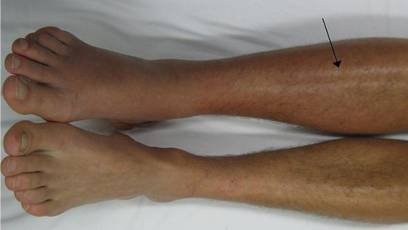

Deep vein thrombosis bruise skin#
Wound care and skincare may also be done for chronic venous ulcers and skin changes associated with chronic venous insufficiency. Pharmacologic procedures are also included, where symptomatic relief of clinical manifestations is done through the administration of medications like diuretics for edema and antibiotics for skin infections. Conservative ProceduresĬonservative procedures include lifestyle modification such as regular exercise to maintain the patient's weight within the ideal range, as obesity is one of the risk factors of chronic venous insufficiency. Ways employed by medical professionals in treating chronic venous insufficiency include conservative treatments and interventional procedures. The management of chronic venous insufficiency entails symptomatic relief. Treatment of Chronic Venous Insufficiency If the non-invasive procedures for testing aren't enough or if surgical treatments are warranted, invasive procedures may also be employed. Computed Tomography or Magnetic Resonance Venography.These may also be complemented with non-invasive procedures such as the following: It also includes a physical examination where the signs and symptoms of chronic venous insufficiency are observed. Venous stasis ulcers - Leg ulcers are chronic, non-healing wounds that may be due to the impairments of proper blood flow to the skin, causing defects in the skin integrity.ĭiagnosis of Chronic Venous Insufficiencyĭiagnosis of chronic venous insufficiency includes careful history taking to determine the risk factors that a patient may possess, like a family history of vascular disease.This is a condition that occurs when blood clots form in the deep veins, and which, when they dislodge from the vein wall, and travel up to the lungs. Venous thromboembolism - Venous thromboembolism is an encompassing term for deep vein thrombosis and pulmonary embolism.These aren't that serious although it brings severe pain to the patient. Superficial thrombophlebitis - Superficial thrombophlebitis describes the condition where inflammatory reactions and blood clot forms in the superficial veins or the veins immediately under the skin.Subjective symptoms - Subjective symptoms associated with chronic venous insufficiency include leg cramps, fatigue, and resting legs syndrome.Ĭomplications of Chronic Venous InsufficiencyĬomplications associated with chronic venous insufficiency are usually brought by poor blood circulation and impairments in clotting functions, which include the following:.Leg edema - Leg edema is the characteristic swelling that is a result of the leakage and build-up of fluid due to the increased permeability of blood vessels.These veins are telangiectasias or spider veins which are dilated venules less than 1 mm in diameter, reticular veins which are dilated veins with diameters of 1 mm to 3 mm, and varicose veins with diameters of more than 3 mm. They may be differentiated from each other based on the diameter size of these veins.



Skin changes - Skin changes that occur as a result of chronic venous insufficiency aside from hemosiderin staining include skin pigmentation or brownish skin, stasis dermatitis, lipodermatosclerosis, and atrophie blanche.Other common symptoms of chronic venous insufficiency include the following: Hemosiderin staining is just one of the clinical manifestations of chronic venous insufficiency, a venous disease that encompasses clinical manifestations not only in the damaged veins but in the skin as well. This is due to the leakage of blood from the blood vessels, bringing with them byproducts like iron, which can leave a stain if the white blood cells fail to clear them up completely. However, this isn't really bruising per se, but only a skin discoloration called hemosiderin staining. It's a common condition that affected legs, ankles, or feet may appear bruised in chronic venous insufficiency.
Deep vein thrombosis bruise free#
FREE Consultation "Bruising" and Other Clinical Manifestations of Chronic Venous Insufficiency


 0 kommentar(er)
0 kommentar(er)
